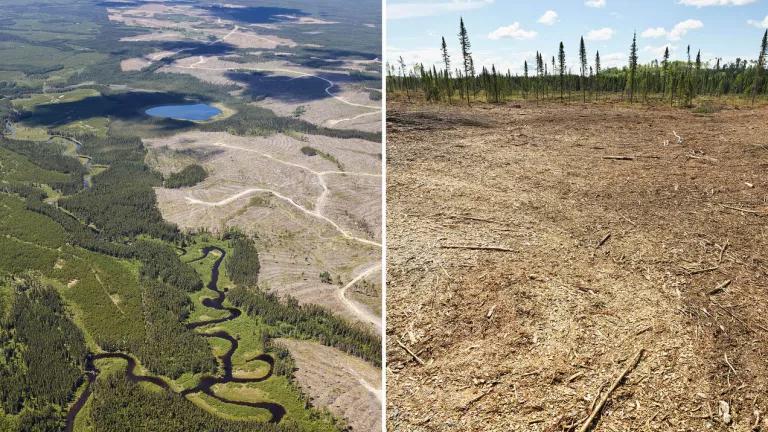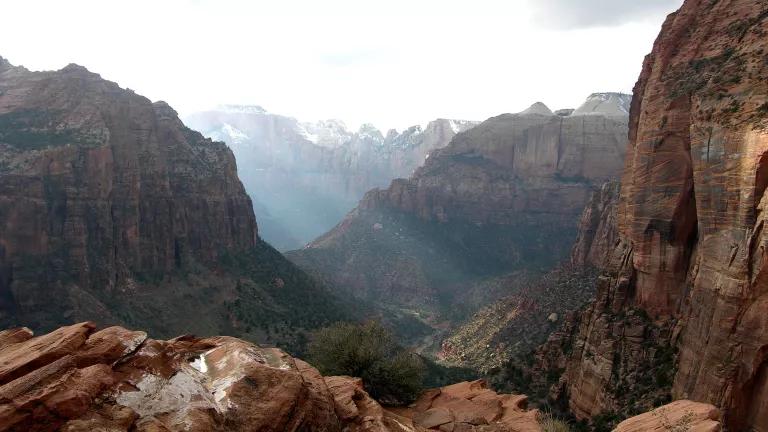Walking the Talk: How Will Canada Halt and Reverse Biodiversity Loss?
NRDC is working with Canadian and international environmental non-governmental organizations to halt and reverse biodiversity loss by 2030.

Delegates applaud the adoption of the Kunming-Montreal Global Biodiversity Framework (GBF) at the 15th UN Biodiversity Conference.
Julian Haber/UN Biodiversity
Now that the dust has settled from the worldwide fanfare celebrating the signing of the Kunming-Montreal Global Biodiversity Framework (GBF) last December, the test of Canada’s resolve begins. With just 7 years to halt and reverse global biodiversity loss, Canada needs to build off its leadership last year by developing a strategy for effecting transformational change at the intersection of ecological recovery and equity.
Plants and animals in Canada are dispersed across various landscapes and ecosystems: forests, grasslands, wetlands, lakes and rivers, coastal ecosystems, oceans, and ice. As the world’s second largest country, Canada's ~3.5 million km2 of forest — located in the boreal and temperate zones — account for about 9% of the world's forests, and a ¼ of the world’s wetlands. Canada also has the world’s longest coastline, 2 million lakes, and the third-largest area of glaciers in the world. Protection and conservation of these ecosystems is of global importance.
However, negative biodiversity trends are evident across Canada. The Committee on the Status of Endangered Wildlife in Canada has identified 841 species that are at risk, with many species yet to be assessed. Industrial development, particularly mining, logging and associated road building, is degrading critical habitats. Canada ranks third in the world for the rate of loss of its intact forests, which hold unique importance to biodiversity conservation. Boreal woodland caribou, one of the most iconic and well-researched animals in Canada that depend on these intact forests, have continued to decline. As of 2017, only 15 of the 51 caribou ranges had enough undisturbed habitat for the populations to survive over the long-term. This year’s unprecedented wildfires in Canada—roughly 15 times the annual average of the past decade—only add to this pressure. There will be long-term implications if the frequency and intensity of wildfires continue to increase.

Number of species in Canada assessed as extirpated, endangered, threatened, and special concern, by taxon (biological classification), as of May 2022.
Committee on the Status of Endangered Wildlife in Canada. (https://www.oag-bvg.gc.ca/internet/English/oth_202210_e_44128.html)
To guide the implementation of its commitments to the GBF, Canada is updating its National Biodiversity Strategy and Action Plan (NBSAP). As critique of Canada’s existing National Biodiversity Strategy have highlighted, policymakers need to pursue a strategy that includes a whole-of-government approach, a shift to a bio-centric mindset, innovative governance (particularly in support of Indigenous-led conservation), and federal leadership with strong levels of financial investment. Further, Canada’s economic emphasis on extraction of natural resources, which is enshrined in the mandates of several government ministries, has created significant barriers to implementing strong nature-positive policies and resulted in slow or limited responses to the climate and biodiversity crises.
Building on our collaboration to support an ambitious new GBF in the lead-up to and at COP-15, NRDC’s Canada Program has joined organizations from across Canada—including the Canadian Parks and Wilderness Society, David Suzuki Foundation, Ecojustice, Nature Canada, Wildlife Conservation Society Canada, and World Wildlife Fund-Canada, among many others—to make recommendations to the Government of Canada and to outline the approaches needed to achieve the goals and targets of the GBF.
Some key recommendations
Our recommendations span several critical priorities.
First, the NBSAP must focus on rebuilding and reconciling relationships with Indigenous Peoples and supporting Indigenous leadership in conservation through a new model of shared decision-making The GBF integrates commitments to uphold Indigenous rights and knowledge systems throughout (e.g., Targets 1, 3, 5, 9, 13, 19, 20 and 22). Canada’s NBSAP must similarly respect and support Indigenous jurisdiction and rights, including the principle of free, prior and informed consent enshrined in the United Nations Declaration on the Rights of Indigenous Peoples (UNDRIP). In alignment with this, Canada should center Indigenous Peoples’ connection to lands and waters, while also ensuring that Indigenous knowledge systems and laws are recognized and respected. Many Nations are already working on their own conservation initiatives, including Indigenous Protected and Conserved Areas, which the federal government can advance by respecting Indigenous laws and enshrining Indigenous title throughout Crown legislation. Additionally, sufficient, long-term funding that meets the needs of Indigenous Nations and communities to support their work to protect, restore and steward lands, waters and wildlife in their territories is essential.

Mutual recognition of Indigenous and Crown jurisdictions throughout the establishment, management and operation of IPCAs can advance effective conservation and provide a pathway for reconciliation.
Conservation Through Reconciliation Partnership
Second, Canada’s NBSAP requires a whole-of-government commitment to ensure all Crown government departments and agencies are pulling in the same direction to halt and reverse biodiversity loss by 2030. This will require a major shift from the status quo, in which some departments are mandated to save nature, while others actively advance activities that drive biodiversity loss. This should include incentivizing provinces and territories to contribute to Canada’s GBF commitments using all available tools (e.g., financial, legal), including by linking federal funding for broader provincial, territorial and municipal priorities (e.g., infrastructure) to delivering measurable outcomes related to NBSAP goals and targets. Additionally, all federal ministers must be directed through their mandate letters to help deliver on the NBSAP goals and targets, similar to what has been done for goals related to climate change, reconciliation with Indigenous Peoples, and gender equity.
Additionally, Canada needs an effective, long-term national biodiversity finance plan, including scaled up long-term public finance as well as a range of other complementary financial tools, increased investment in nature-positive economies, and a complete repeal of all harmful subsidies, including those for oil and gas, mining, and industrial logging. While there have been significant federal investments in nature conservation in recent years, the short-term nature of this funding supports limited progress.
Globally and in Canada, habitat loss and degradation is the most significant direct driver of biodiversity loss on land. GBF Targets 1 and 3 are key to stopping the loss of habitat and permanently protecting ecosystems with significant ecological and cultural values. Ensuring the quality, quantity and equity elements of these targets are implemented, tracked and reported on is necessary for achieving biodiversity conservation outcomes. For example, while Canada has committed to protect at least 30% of land, freshwater and ocean areas by 2030, Canada needs to prioritize the quality of the protected areas, not just its size-based target. The government should emphasize protecting areas that are: important for biodiversity; ecologically representative; well-connected; effectively conserved and managed; equitably governed; and recognize Indigenous rights and territories. When questioned about how Canada would achieve this ambitious target, Prime Minister Trudeau stated that he believes industrial activity, including mining, could be consistent with conservation, raising concerns that Canada is feeling the pressure to accept a revisionist paradigm of conservation.
Properly designed, the NBSAP will also help align industrial logging with sustainable practices, including through halting forest degradation by 2030, as Canada committed to in the Glasgow Leaders’ Declaration on Forests and Land Use, and reducing logging levels in regions with significant loss of mature forests due to increased natural disturbance. This will not only allow Canada to achieve its environmental targets, but better position the sector to remain competitive in an increasingly sustainability-focused marketplace. The NBSAP should also include provisions aligning Canada’s climate policy and emissions reporting with biodiversity protection, including through requiring transparent reporting on GHG emissions from industrial logging.
The GBF was designed to be implemented holistically, with all goals and targets working together to halt and reverse biodiversity loss by 2030 and achieve the vision of living in harmony with nature by 2050. With less than a decade to change its trajectory to one of biodiversity decline to one of species recovery, it’s imperative that Canada mobilize the substantial resources and political will necessary to achieve this transformational change.



